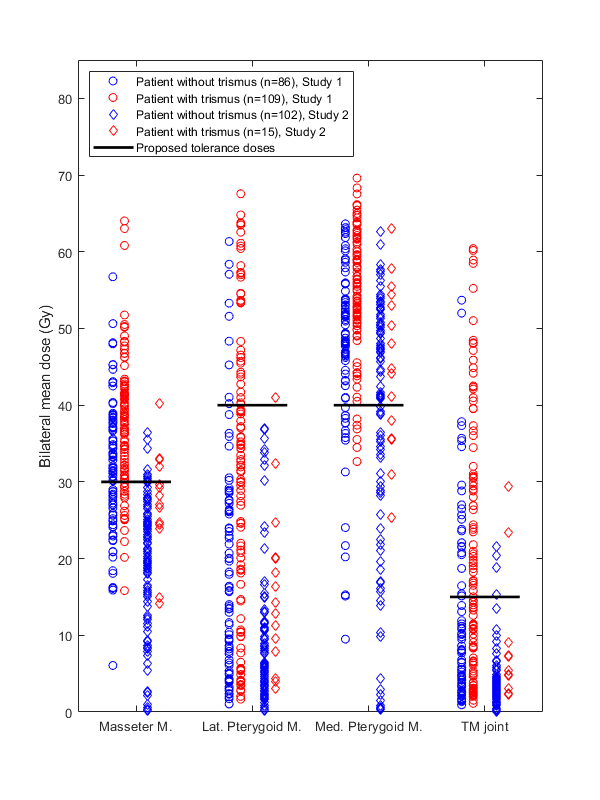Head and neck cancer mastication structure doses by older and newer external beam RT techniques
Niclas Pettersson,
Sweden
PO-1098
Abstract
Head and neck cancer mastication structure doses by older and newer external beam RT techniques
Authors: Niclas Pettersson1,2, Nina Pauli3,4, Emelie Andersson3, Lisa Tuomi4,3, Caterina Finizia4,3, Caroline Olsson2,5
1Region Västra Götaland, Sahlgrenska University Hospital, Dept of Medical Physics and Biomedical Engineering, Gothenburg, Sweden; 2Institute of Clinical Sciences, Sahlgrenska Academy, University of Gothenburg, Department of Medical Radiation Sciences, Gothenburg, Sweden; 3Head and Neck surgery, Institute of Clinical Sciences, Sahlgrenska Academy, University of Gothenburg, Department of Otorhinolaryngology, Gothenburg, Sweden; 4Region Västra Götaland, Sahlgrenska University Hospital, Department of Otorhinolaryngology, Gothenburg, Sweden; 5the Western Sweden Healthcare region, Sahlgrenska University Hospital, Regional Cancer Center West, Gothenburg, Sweden
Show Affiliations
Hide Affiliations
Purpose or Objective
Doses to mastication
structures critical for radiation-induced trismus in head and neck cancer (HNC)
depend on radiation therapy (RT) technique. Doses by older, less conformal, RT
techniques often exceeded currently proposed tolerance doses, but it is unknown
how newer techniques fare in this context. The purpose of this work was to investigate
how doses to the temporomandibular (TM) joint, masseter muscles, and pterygoid
muscles in VMAT for HNC compared to earlier RT techniques.
Material and Methods
We investigated
two HNC patient cohorts treated with external beam RT at the Sahlgrenska
University Hospital, Sweden, in 2007-2012 (3D-CRT and/or IMRT; n=195 [study 1])
or 2017-2020 (VMAT; n=117 [study 2]). All patients had undergone RT without
mastication-structure-sparing intent. All included patients had normal
mouth-opening ability before RT and were followed up with respect to trismus
status at 3, 6 and 12 months post RT. Trismus was defined as maximal interincisal
opening [MIO] ≤35 mm at any post-RT follow up. The TM
joint, masseter and medial/lateral pterygoid muscles were consistently delineated
on the planning CT:s. Mean dose comparisons for structures were made using Student’s
unpaired t-test. P-values≤0.05 indicated statistical
significance.
Results
Within 12
months post RT, 109/195 (56%) of patients in study 1 had experienced trismus compared
to 15/117 (13%) in study 2. Averaged mean doses (±1 SD) for the masseter
muscles were 17.6±4.5 Gy in study 1 and 10.0±4.6 Gy in study 2 (p<0.001). Corresponding numbers were 8.5±7.6 Gy and 2.3±2.5 Gy for the TM joints (p<0.001),
25.9±5.1 Gy and 19.1±8.4 Gy for the medial
pterygoid muscles (p<0.001), and 13.0±9.0 Gy and 4.8±4.8 Gy for the lateral pterygoid muscles (p<0.001). Masseter muscle doses
were above the proposed tolerance in 73% of patients in study 1 compared to 12%
in study 2 (Figure 1). The corresponding numbers were 44% and 6% for the TM
joints, 88% and 58% for the medial pterygoid muscles and 22% and 1% for the
lateral pterygoid muscles.

Figure 1. Mean
mastication structure doses for patients with trismus (red) and without trismus
(blue) given older (leftmost/structure) and newer (rightmost/structure) RT
techniques. Tolerance doses for 10% risk of trismus: 30 Gy for masseter
muscles; 15 Gy for TM joint, and 40 Gy for medial/lateral pterygoid muscles (Pauli
N et al. Acta Oncol 2016: 55:788; Rao SD et al. Acta Oncol 2016:55:99; Kamal M
et al. RO 2020:149:142; Hauge C et al. Acta Oncol 2018:57:1038).
Conclusion
Modern RT without
mastication-structure-sparing intent resulted in 77% trismus reduction in HNC
patients compared to patients treated with older techniques. Mastication
structures mean doses by VMAT were generally below currently proposed tolerance
doses, with dose reductions around 6-8 Gy for all structures compared to older
techniques. The margin to “safe” dose levels were smaller for the medial
pterygoid muscles compared to the other structures suggesting that focusing on
this structure may lower trismus rates further.